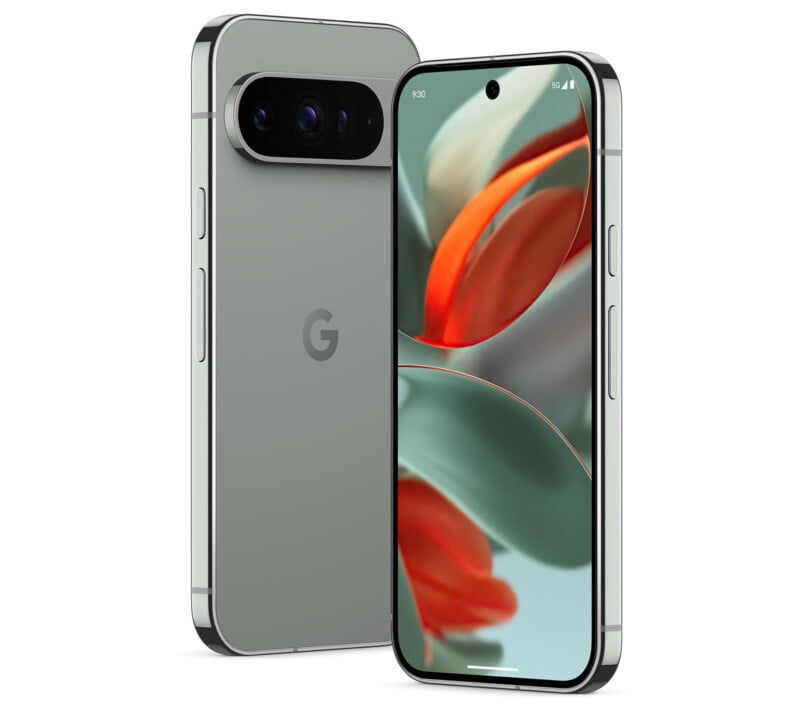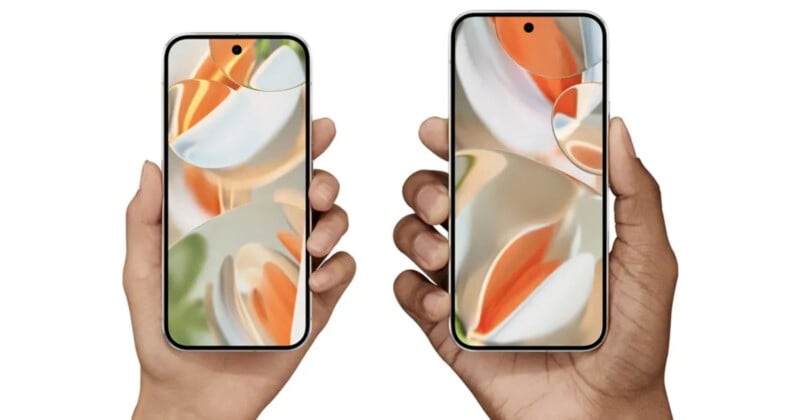Google Pixel 9 Pro Features Improved Cameras and a Bold New Look
![]()
Google teased the new Pixel 9 Pro ahead of its Made by Google launch event, showing off a redesigned camera bar. As it turns out, there’s more to the changes than meets the eye, and the Pixel 9 Pro and Pixel 9 Pro XL promise Pixel’s best camera system yet.
The Pixel 9 Pro Receives a ‘Sophisticated’ Facelift
Starting with the new design, Google calls the facelift “sophisticated” and “stunning.” Like with the standard Pixel 9, the Pixel 9 Pro and Pro XL ditch the full-width camera bar that has become emblematic of the Pixel series in favor of a rounded camera bar. While the redesign received some criticism following Google’s teaser videos, the company itself says the design “celebrates the iconic Pixel camera” and delivers a sculpted, sleek form with improved durability.
The Pixel 9 Pro series has a silky matte glass finish, a dual-finish camera bar, and a polished metal frame. The phone’s front and back feature Corning Gorilla Glass Victus 2, and it is IP68 dust and water-resistant.
The most significant and really only difference between the Pixel 9 Pro and the 9 Pro XL is their size and screens. The Pixel 9 Pro has a 6.3-inch Super Actua display (LPTO) with 1,280 x 2,856 resolution and a Smooth Display refresh rate from one to 120Hz. The larger phone, the Pixel 9 Pro XL, has a 6.8-inch display with 1,344 x 2,922 resolution and the same 1-120Hz refresh rate. Both phones have an OLED panel that promises up to 2,000 nits of brightness for HDR content and 3,000 nits of peak brightness. Beyond the size, the only difference is that the Pixel 9 Pro has a 495 PPI resolution, while the Pixel 9 Pro XL has 486 pixels per inch. This tiny difference should be entirely indiscernible in use.

In terms of overall dimensions, the Pixel 9 Pro is six inches tall, 2.8 inches wide, and 0.3 inches thick (152.8 x 72 x 8.5 millimeters), and the phone weighs seven ounces (199 grams). The Pixel 9 Pro XL is 6.4 inches tall, three inches wide, and 0.3 inches thick (162.8 x 76.6 x 8.5 millimeters) and weighs 7.8 ounces (221 grams).

Google Pixel 9 Pro’s Triple Rear Camera System
The Pixel 9 Pro and XL feature identical “Pro triple rear camera systems.” The 50-megapixel Octa PD wide camera has a Type 1/1.31 image sensor paired with an f/1.68 lens that offers 82 degrees of field of view.
Moving to the ultrawide camera, it is a 48-megapixel Quad PD module with an f/1.7 lens, a 123-degree field of view, and a Type 1/2.55 image sensor. While the Pixel 8 Pro’s ultrawide camera also has 48 megapixels, it’s not the same as this new one. The older phone had a slower f/1.95 lens, for starters, and slightly more field of view (125.5 degrees). This new 48MP ultrawide camera is the same one that Google added to the standard Pixel 9, and like the implementation there, the ultrawide is the macro camera on the Pixel 9 Pro.
![]()
Something the Pixel 9 lacks, however, is the Pixel 9 Pro’s 48-megapixel Quad PD telephoto camera. This is unchanged from the Pixel 8 Pro, and the telephoto camera has an f/2.8 lens, 22-degree field of view, five times optical zoom, and Super Res Zoom up to 30x. This camera has a Type 1/2.55 image sensor, like the ultrawide module.
Thanks to the triple camera setup, with its various focal lengths and optical zooming capabilities, Pixel 9 Pro shooters can shoot at 0.5x, 1x, 2x, 5x, and 10x without digital zoom. Of course, Super Res Zoom offers even more reach and is available in video for the first time on a Pixel smartphone. While Super Res Zoom goes to 30x for photos, it is limited to 20x for video.
![]()
Another new video feature is Video Boost, which can enhance videos up to 8K resolution. Without Video Boost, the resolution is capped at 4K. The Pixel 9 Pro can record up to 60 frames per second during standard recording and up to 240 frames per second using Slo-mo video.
Additional video modes are available, including 10-bit HDR, Cinematic Blur and Pan, 4K timelapse, Astronomy timelapse, Night Sight, and more.
Although not as popular for photography as the rear cameras, the Pixel 9 Pro includes an all-new front-facing camera. The upgraded camera has a 42-megapixel sensor, f/2.2 aperture, and 103-degree field of view. It is the highest-resolution and widest-angle self-facing camera Google has included in a Pixel device.
![]()
Rounding out the Pixel 9 Pro’s features are Pro controls. These aren’t new this year but remain a key differentiator between the standard Pixel 9 and the Pixel 9 Pro smartphones. Pro controls provide photographers with direct, manual control over camera settings and have proven popular with smartphone photographers.
The Pixel 9 Pro Has a lot of AI
The Pixel 9 Pro features a lot of AI, continuing the trend Google started with its prior smartphone models. Features like Magic Editor and Magic Eraser return, allowing photographers to quickly edit and improve their images with a few taps.
New this year is Add Me, which is releasing first as a tech preview. This mode lets someone capture a group portrait, swap spots, and be included in a final composite. Gone are the days when the camera person missed out on the fun. This relies on technology similar to Best Take, which selects the best version of each portrait subject from a series of photos and combines them into a single frame.
![]()
Additional intelligent camera features include Night Sight, Astrophotography, Portrait Mode, Long Exposure, Action Pan, Panorama, and more. As for clever editing functions, the Pixel 9 Pro also includes Photo Unblur, Zoom Enhance, and Portrait Light.
There’s also Google Gemini. Google has been giving its Gemini AI platform much attention this year, so seeing it make a big splash with the Pixel 9 series is not surprising. Gemini can help people find info in Google apps, plan events, answer questions, and perform on-device tasks. “You can even snap a photo, and use Gemini to get answers — like how to save a dying plant in your window, or what recipe you can make from what’s in your fridge,” Google explains.
Pixel 9 Pro comes with Google’s One AI Premium Plan, which provides one year of free access to Gemini Advanced. This plan includes Google’s best AI features plus 2TB of cloud storage.
All the Pixel 9 devices include Pixel Screenshots, which lets users save information by taking screenshots. The on-device AI scans the content and helps users save and organize relevant information, which can be retrieved later using conversational-style request prompts.
![]()
Performance
All the new camera and AI features are powered by Google’s latest Tensor G4 chip, and security is provided via a Titan M2 security coprocessor. The Pixel 9 Pro and 9 Pro XL each feature 16GB of RAM and come in 128GB, 256GB, 512GB, and 1TB capacities.
While the 9 Pro XL has a bigger battery (5,060 mAh versus 4,700 mAh), both phones promise 24-plus hour battery life in everyday use and up to 100 hours when using the Extreme Battery Saver mode. There is one slight difference, though: the XL can fast charge up to 70% in 30 minutes, while the standard 9 Pro tops out at 55% over the same charging period. Both devices also support fast wireless charging (Qi-certified) and Battery Share.
![]()
Pricing and Availability
The Google Pixel 9 Pro starts at $999, while the base 9 Pro XL model is $1,099. Both phones come in multiple colors, including Obsidian, Porcelain, Hazel, and Rose Quartz. Per usual, Google promises seven years of OS, security, and Pixel Drop (feature) updates. The Pixel 9 Pro ships with Android 14 and is available to order now and will ship on September 4th. The Pixel Pro XL will arrive a bit earlier, hitting store shelves on August 22nd.
Image credits: Google